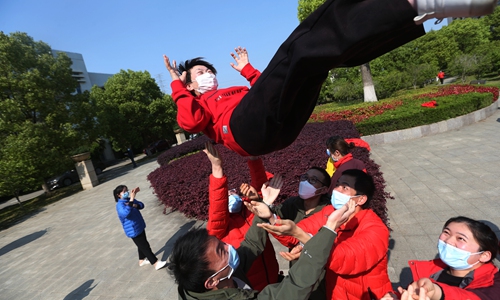AP report on China’s ‘delayed’ epidemic response conveniently passes blame
By Chen Qingqing Source:Global Times Published: 2020/4/16 22:43:33

Members of a medical team sent to aid Central China's Hubei Province during the COVID-19 epidemic throw Liu Ying, an ICU head nurse, into the air on Sunday to celebrate a phased victory in the fight against the virus. Photo: Cui Meng/GT
Understanding the novel coronavirus is not an easy process, which needs comprehensive in-field investigation and data collection to make a judgment that is always "easy to say but hard to do," the chief epidemiologist of the China Center for Disease Control Center (CDC), said in response to the latest reporting by the Associated Press (AP) claiming Chinese officials didn't warn the public of a looming outbreak for the six key days in January which would have largely reduced the infection numbers.
The AP said top Chinese health officials laid out an assessment of the situation of the novel coronavirus pneumonia (COVDI-19) outbreak in a confidential document on January 14, however, the public was warned on January 20. If the public had been warned a week earlier to take actions such as social distancing, mask-wearing and travel restrictions, cases could have been cut by up to two-thirds, AP's re-port said, citing a research paper entitled Effect of non-pharmaceutical interventions for containing the COVID-19 outbreak in China published on medrxiv.org.
"It only gave China less than a month to look into the new virus, do in-field researches, it's a process of deepening the understanding on the outbreak, from little to more," Zeng Guang, the chief epidemiologist of the China CDC, told the Global Times on Thursday. "From limited human-to-human risks to more outbreaks outside Hubei, it takes time for us to know the facts," he said.
Scientists and epidemiologists have repeatedly emphasized that there are a lot of unknowns with the COVID-19, and even the US President Donald Trump compared the COVID-19 cases to influenza, trying to play down the impact of the disease on the population.
After China submitted to the World Health Organization (WHO) the genome sequence of COVID-19 on January 12, the National Health Commission (NHC) unveiled the first version of guidelines on the diagnosis and treatment for COVID-19 on January 15, along with prevention and control measures, according to the document released by the Chinese government on April 6 on the timeline of China releasing information on COVID-19 and international cooperation on epidemic response.
Since January 16, Wuhan, Central China's Hubei Province, took proactive measures to screen all patients treated for fever clinics and the commission sent seven inspection teams to different provincial-level regions to instruct local epidemic prevention and control work.
Though the number of cases in Wuhan had increased substantially at that time, and a simple and effective rapid diagnostic method had not yet been established. And during that time, reporting of COVID-19 cases across the country also required full-gene sequencing data, which caused technical obstacles for the network to directly report the disease, Shanghai-based infectious disease expert Zhang Wenhong who has also been leading epidemic prevention work said in a memo published earlier, as commenting on whether there was a window of opportunity before January 20.
It is also a process for policy-makers to fully absorb the information of the situation, coordinating with all levels of authorities before coming up with a decision that helped mitigate the impact of the out-breaks,analysts said.
"The lockdown of Wuhan was a timely decision. Local authorities could not shut down a city with a relatively small number of patients while people had little knowledge about how contagions it is," Yang Zhanqiu, deputy director of the pathogen biology department at Wuhan University, told the Global Times on Thursday.
Regarding the assumption that earlier measures by China would reduce confirmed cases, "it's a model of mathematic calculation, which does not have much value," he said, noting that the way Chinese authorities handled the matter is in line with the cognitive rules concerning disease evolvement.
On January 19, the NHC started to distribute nucleic acid testing re-agents to health departments across the country, and top medical ex-pert Zhong Nanshan confirmed human-to-human transmission the next day.
"We have had considered various factors including it was the Spring Festival travel peak season at that time, but we took decisive action no matter what," Zeng said, noting that the US, however, took much longer time to implement containment measures.
Some netizens on Twitter also claimed that instead of blaming China for losing six days to control the situation, the US should be criticized for taking over a month to react. "6 days… faster than Trump warned us…" Alexander Morehouse, a netizen from Florida said in a post.
Posted in: SOCIETY